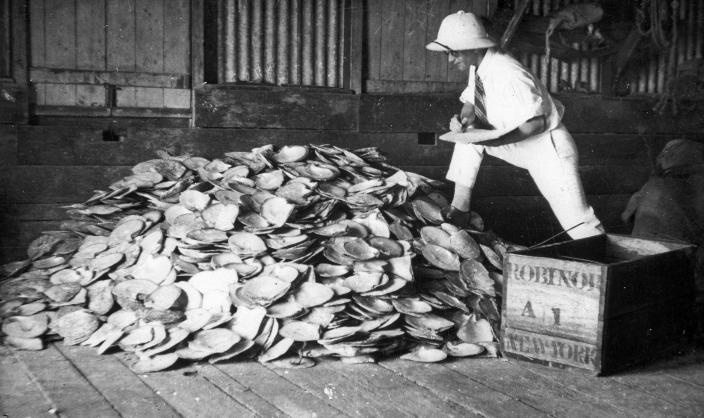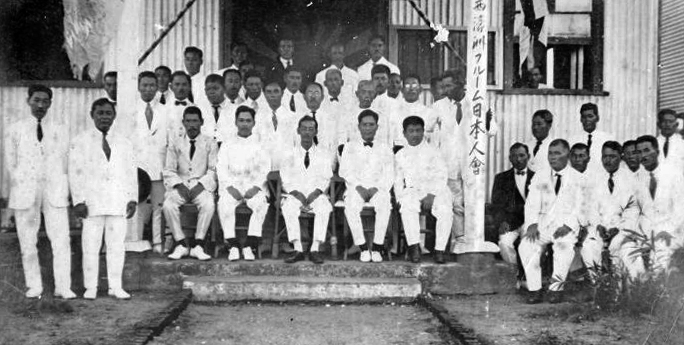
Research | Forschungsinteressen
About Me | Publications | WiP | Talks & Conferences
Research Foci | Forschungsfokus: Sugar | Pearls | Human Remains | Amalie Dietrich
›Mongrelia‹ Down Under?
Broome and ›The Hole in White Australia‹
After my extensive study on ›Consuming Whiteness‹, I have tackled a new project. Here is an excerpt from the project outline:
Exception or Exemption?
The Broome Pearling Industry and the ›White Australia‹ Policy
In 1899, a journalist investigated the north-western pearling industry. The three-part report published in the Melbourne ›Age‹ described Broome as a scenery that »would utterly puzzle the cleverest ethnologist« due to it »mixing of nationalities and hybrids«, which would continue »until Mongrelia is literally the name which should be applied to the region«.1 The reporter concluded his observations of the pearling industry – whose treatment of the Indigenous Australians he described as »a blot upon Australia«2 – with an emphatic demand for a ›whitening‹ of an industry that he considered »a menace to the future welfare of the continent« and »suicidal« with regard to »national progress«.3 This view of the situation corresponded with the long-term opposition of the Labor Party. From the first debates about an amendment to the Immigration Restriction Bill exempting the pearling industry, members of the Labor Party emphasized not only the socio-economic effects of a continued introduction of ›coloured labour‹ – the substratification of the society with a class of workers undercutting the wages of the ›white‹ workers; they, too, argued »on ground of racial contamination« and racial hygiene.4

Fears of a take-over by the Japanese, who numerically dominated the pearling industry by the mid-1890s, blended with the general, nation-wide antagonism towards the ›yellow peril‹ and wide-spread concerns about an ostensibly imminent invasion by ›Asian hordes‹.5 On their way to Federation, the Australian colonies drove a hard bargain concerning questions of immigration and ›alien labour‹. Not least the nation-building was based on a constitution that had as a main focus the maintenance of a racially homogenous – i.e. ›white‹ – society.6 After all, the ›white Australia policy‹ did not only rigidly restrict the immigration of undesired population groups but also laid the foundation for a holistic sociodemographic transformation in Queensland. In the case of the sugar industry, the accession to the Federation meant the deportation of the traditional labour force, the South Sea Islanders, in favour of making it a »white man’s industry«.7
Against this backdrop, and the broader atmosphere of the time, it seemed certain that the pearling industry should have had little chance to assert itself against the demands to replace the Japanese, Malayans and other non-white workers, including the diminishing number of Indigenous Australians, with British and other European workers.

Yet, despite several attempts to transform the industry, peaking in 1911/12,8 the pearlers’ resistance led to »the only formal exception ever made to the White Australia Policy«,9 and the pearling industry is today described as a »rare exemption from the White Australia policy«,10 a »hole in White Australia«11 and »Australia’s sole exception«12 from the prohibition of coloured labour. The Australian Government’s official website even locates this special status geographically and states that »Broome was made an exception to the White Australia Policy«.13
This project picks up on the definitional area of tension created by the Broome industry as ›exception‹ or ›exemption‹ and investigates not only into processes within the pearling industry but also situates it into a broader societal and cultural context within an Australian but also global frame.
As two extremes, ›exception‹ considers the pearling industry as a special provision for a situation in which, in the face of the pearl-shells’ value and white unfitness, the prevailing racism receded behind the economic significance of the pearling industry; ›exemption‹ would mean a special position, an exceptional situation in which racism was subdued and a chance of multicultural coexistence seemed feasible. The former leaves open the question of the pearlers’ legitimation of their special status in the light of the nation-wide anti-Asian reasoning and the strong opposition against the introduction of non-European labour. Whereas the latter permits the examination of Broome’s social scenery in terms of a ›positive utopia‹ – inspired by the Black Atlantic studies – which focusses on intra- and international mediation and processes of transnational cohabitation in a rather isolated part of the Australian continent. In any case, the tension between ›exception‹ and ›exemption‹ mirrors the political and societal distortions in the history of the pearling industry and the long-term negotiations about manner and methods of its perpetuation in the context of ›white Australia‹.

Notes
1 ›With a Pearling Fleet. No. I – The Work in North-West Australia‹, in: Age, 16.8.1899, p. 7.
2 ›With a Pearling Fleet. No II – An Australian slave trade‹, in: Age, 23.8.1899, p. 11.
3 ›With a Pearling Fleet. No. III – Is Asiatic labour necessary?‹, in: Age, 26.8.1899, p. 4.
4 John C. Watson, Hansard on Immigration Restriction Bill, 1.10.1901.
5 See, i.a., David Walker: Anxious Nation. Australia and the Rise of Asia; 1850 - 1939. St Lucia: University of Queensland Press 1999; Anne Aly, David Walker: Veiled Threats. Recurrent Cultural Anxieties in Australia, in: Journal of Muslim Minority Affairs, 27, 2007, 2, pp. 203-214; Bill Hornadge: The Yellow Peril. A squint at some Australian attitudes towards Orientals. Dubbo: Review Publications 1971.
6 For the making of ›white Australia‹, see, amongst others, Jane Carey Claire McLisky (eds.): Creating White Australia. Sydney: Sydney University Press 2009; Laksiri Jayasuriya, David Walker, Jan Gothard (eds.): The Legacies of White Australia. Race, Culture and Nation. Crawley, WA.: University of Western Australia Press 2003; Jürgen Matthäus: Nationsbildung in Australien von den Anfängen weißer Besiedlung bis zum Ersten Weltkrieg. (1788 - 1914). Frankfurt am Main: Lang 1993; and the classic: Myra Willard: History of the White Australian Policy to 1920. Melbourne: University of Melbourne 1967 (1923).
7 ›Sugar Production. A White Man’s Industry‹, in: Argus, 18.12.1909, p. 21.
8 See John Bailey: The White Divers of Broome. The true story of a fatal experiment. 5th repr. ed. Sydney: Pan Macmillan 2004.
9 Regina Ganter: Images of Japanese Pearl-Shellers in Queensland. An Oral History Chapter in Australia-Japan Relations, in: Royal Historical Society of Queensland Journal, 14, 1991, 7, p. 265.
10 Julia Martínez: Indonesians Challenging White Australia, in: Indonesia and the Malay World, 40, 2012, 117, pp. 231-248.
11 Humphrey McQueen: Social Sketches of Australia, 1888-2001. Rev. ed. St Lucia: University of Queensland Press 2004, p. 69.
12 Lorraine Philipps: Plenty More Little Brown Man! Pearlshelling and White Australia in Queensland, 1901-18. In: Essays in the Political Economy of Australian Capitalism, ed. by E. L. Wheelwright, Ken Buckley. Sydney: Australia and New Zealand Book Co. 1980, pp. 58-84.
13 Australian Government: Australia's Pearling Industry; accessed Nov 2017.
14 ›The Black North West‹, in: Bulletin, 2.4.1898. The ›Bulletin‹ was a central mouthpiece of the ›white Australia policy‹. It reacted with its usual racist rhetoric to the employment of Malayan and Japanese workers.
Initial deliberations have already been and will be published:
- »... polished and cultured, speaking English fluently«
The Coming of Broome's First Japanese Doctor
In: Documenting Migration in the Japanese Empire and beyond, ed. by Takahiro Yamamoto, Singapore: Palgrave 2022 (forthcoming 2022) - A Japanese Galen Down Under
Dr Suzuki, Broome, and the Intricacies of White Australia
In: Migrant Australia. From Botany Bay to Manus Island, ed. by Katrin Althans, David Kern, Beate Neumeier. Trier: wvt, KOALAS, Vol. 15, 2021, pp. 105–116 - Conflicts in Racism
Broome and White Australia
In: Race & Class, 61, 2019, 2, pp. 43–61, with Wulf D. Hund, doi: 10.1177/0306396819871412 (refereed article) - The White Experiment
Racism and the Broome Pearling Industry
In: Anglica. An International Journal of English Studies, 28, 2019, 3, pp. 43–58; doi: 10.7311/0860-5734.28.3.05 (refereed article, open-access)